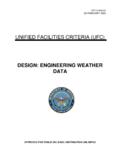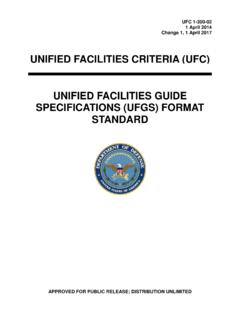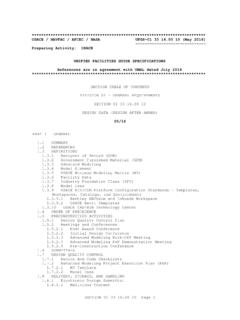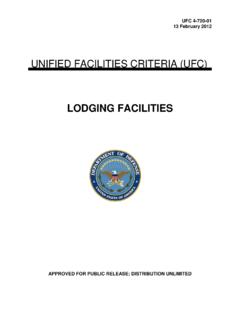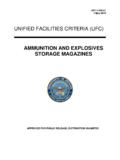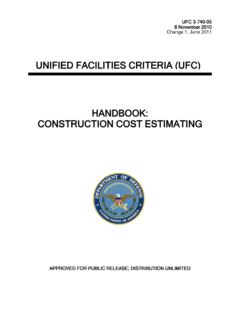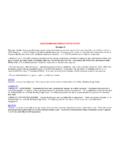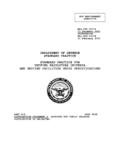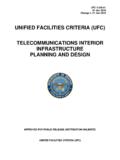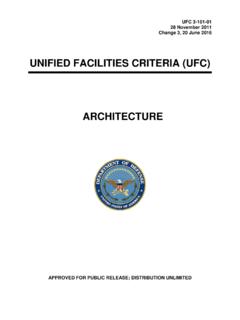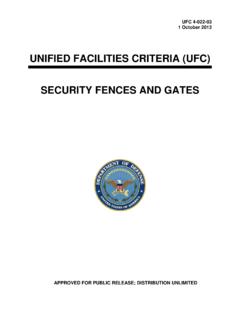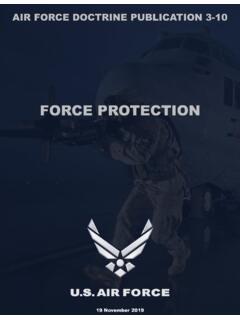Transcription of FM 3-19.30 Physical Security - Whole Building Design Guide
1 (Formerly FM 19-30). Headquarters, Department of the Army DISTRIBUTION RESTRICTION: Approved for public release; distribution is unlimited. *FM Field Manual Headquarters No. Department of the Army Washington, DC, 8 January 2001. Physical Security . Contents Page vi Chapter 1 Physical - Security CHALLENGES ..1-1. Automated Information 1-1. OPSEC and the Threat .. 1-3. Chapter 2 THE SYSTEMS 2-1. Protective Systems .. 2-1. Systems 2-2. The Integrated Protective System ..2-5. Security 2-6. Chapter 3 Design APPROACH .. 3-1. Design Strategies .. 3-1. Protective Measures .. 3-1. Vehicle Exterior Attack .. 3-10. Standoff Weapons .. 3-13. 3-16. Forced Entry ..3-17. Covert Entry and Insider Surveillance and Eavesdropping ..3-20. Mail and Supply Bombs ..3-22. Chemical and Biological Contamination ..3-24. Chapter 4 PROTECTIVE BARRIERS .. 4-1. Fencing .. 4-2. Utility 4-5. Other Perimeter 4-5. Security Towers.
2 4-5. Installation Entrances ..4-6. Warning Signs ..4-8. Other Installation Perimeter Roads and Clear Zones ..4-8. Arms-Facility Structural Standards ..4-9. Distribution Restriction: Approved for public release; distribution is unlimited. *This publication supersedes FM 19-30, 1 March 1979. i FM Page Chapter 5 Physical - Security LIGHTING .. 5-1. Overview .. 5-1. Commander's 5-1. Planning Considerations .. 5-2. Principles of Security Lighting .. 5-3. Types of 5-4. Wiring Systems .. 5-5. 5-6. Chapter 6 ELECTRONIC Security SYSTEMS .. 6-1. Overview .. 6-1. ESS Design Considerations .. 6-2. Interior ESS Considerations .. 6-7. Exterior ESS 6-8. ESS Alarm-Annunciation 6-12. ESS 6-17. Interior Intrusion-Detection 6-18. Exterior Intrusion-Detection Sensors .. 6-29. Electronic Entry Control .. 6-39. Application 6-42. Performance Criteria .. 6-43. Data Transmission .. 6-44. CCTV for Alarm Assessment and 6-45. Chapter 7 ACCESS CONTROL.
3 7-1. Designated Restricted Areas .. 7-1. Employee Screening .. 7-4. Identification System .. 7-4. Duress Code .. 7-10. Access-Control Rosters .. 7-10. Methods of 7-10. Security Controls of Packages, Personal Property, and 7-11. Tactical-Environment Considerations .. 7-12. Chapter 8 LOCK AND KEY 8-1. Installation and Maintenance .. 8-1. Types of Locking Devices .. 8-1. Chapter 9 Security FORCES .. 9-1. Types of Security Forces .. 9-1. Authority and Jurisdiction .. 9-2. Personnel Selection .. 9-3. Security 9-3. Organization and Employment of Forces .. 9-4. Headquarters and Shelters .. 9-4. Execution of Security Activities .. 9-5. Training 9-6. Supervision .. 9-7. 9-8. 9-9. Firearms .. 9-9. ii FM Page Communications .. 9-9. Miscellaneous Equipment .. 9-9. Military Working Dogs .. 9-10. Summary .. 9-10. Chapter 10 IN-TRANSIT 10-1. In-Port 10-1. Rail Cargo .. 10-4. Pipeline 10-6. Convoy Movement .. 10-7.
4 Chapter 11 INSPECTIONS AND SURVEYS .. 11-1. Inspections .. 11-1. Surveys .. 11-2. Appendix A METRIC CONVERSION CHART .. A-1. Appendix B SAMPLE INSTALLATION CRIME-PREVENTION B-1. Section I Installation Crime-Prevention Programs ..B-1. Crime-Prevention Working Groups .. B-1. Crime-Prevention Officers .. B-2. Crime-Prevention Program Development ..B-2. Training ..B-5. Civilian Crime-Prevention Section II Criminal Analysis ..B-5. Sources of Information ..B-6. Individual Criminal Analysis .. B-9. Criminal-Analysis Procedures .. B-15. Criminal-Analysis Summary .. B-17. Section III Command and Law-Enforcement Countermeasures .. B-17. Crime Hot Lines .. B-17. Crime Prevention Through Environmental Design .. B-18. Specialized Patrol Tactics and Surveillance ..B-25. Publicity Residential- Security Surveys ..B-31. Juvenile Crime Prevention ..B-34. Fraud ..B-47. Internal Theft ..B-52. Pilferage ..B-53. Section IV Army Property at the Local Level.
5 B-61. Motor Vehicles ..B-61. Consumer Outlets ..B-63. Arson ..B-66. Section V Community Crime-Prevention Neighborhood Watch Operation ID ..B-71. Neighborhood Walks ..B-74. Vigilantism ..B-75. Mobile Patrols ..B-76. Project Lock ..B-76. Section VI Evaluation ..B-79. iii FM Page Crime-Prevention Crime Rates ..B-83. Measures of Effectiveness ..B-84. Internal Measures ..B-85. Appendix C INTELLIGENCE, COUNTERINTELLIGENCE, AND THREAT ANALYSIS ..C-1. Information Sources ..C-1. Responsibilities of US Government Lead Information Threat Analysis and Determination of the Threat Appendix D CRISIS-MANAGEMENT PLAN ..D-1. Appendix E OFFICE Security MEASURES ..E-1. Physical - Security Survey ..E-1. Security -Engineering Assessment ..E-1. Technical Assessment of Responses ..E-2. Physical - Security Enhancement Appendix F Physical - Security F-1. Annexes .. F-6. Tactical-Environment Considerations .. F-7. Appendix G PERSONAL-PROTECTION MEASURES.
6 G-1. Personal G-1. Working G-2. Home Environment .. G-4. Appendix H General ..H-1. Concealing Bombs ..H-1. Damage and Casualty Mechanisms ..H-1. Telephonic Threats ..H-3. Evacuation Drills ..H-3. Searching for a Suspected Appendix I EXECUTIVE PROTECTION .. I-1. Supplemental Security Measures .. I-1. Executive Protection Goals .. I-1. Residential Security I-2. Transportation Measures .. I-4. Individual Protective Measures .. I-7. Combating-Terrorism Training for I-10. Travel to Potential Physical -Threat Risk Areas .. I-10. Protective Security Details .. I-10. Executive-Protection System Integration .. I-12. Appendix J RESOURCE J-1. Funding J-1. iv FM Page Projected J-1. Obligation Plan .. J-1. Types of Appropriations .. J-2. Appendix K VULNERABILITY Assessment THREATCON Levels ..K-2. Assessing Vulnerability ..K-3. GLOSSARY .. Glossary-1. Bibliography-1. INDEX .. Index-1. v Preface This field manual (FM) sets forth guidance for all personnel responsible for Physical Security .
7 It is the basic reference for training Security personnel. It is intended to be a one-stop Physical - Security source for the Department of Defense (DOD), the Department of the Army (DA), and other proponents and agencies of Physical Security . Prevention and protection are the two primary concerns of Physical Security . Both serve the Security interests of people, equipment, and property. These interests must be supported at all staff and command levels; and this support must be unified in joint, multinational, and interagency operations. Support to joint, multinational, and interagency operations relies on the fact that the Army will not conduct operations alone. Additionally, force-projection operations conducted by the military will involve the integration of war-fighting capabilities with stability and support operations. This manual's primary focus is the articulation of a balanced understanding of Physical Security for joint, multinational, and interagency operations throughout the environments of peacetime, conflict, and war (whether in the continental United States [CONUS] or outside the continental United States [OCONUS]).
8 Physical Security must integrate the various capabilities of joint, multinational, and interagency operations in pursuit of a seamless connection between the strategic, operational, and tactical levels of war. Physical Security must also address an expanded range of threats that embraces not only traditional threat components of war, but also nontraditional threats generated by guerrillas, terrorists, criminals, and natural or man-made disasters. In addition, Physical Security must address the concept of Homeland Defense due to the aforementioned threats. Homeland Defense is the military's role in the United States (US) government's principal task of protecting its territory and citizens. This is accomplished by joint, interagency, and multijurisdictional organizations. Homeland Defense includes . Supporting domestic authorities for crisis and consequence management with regard to weapons of mass destruction (WMD).
9 Protecting national- Security assets (such as installations) and deploying forces and ensuring the availability, integrity, and adequacy of other critical assets. Deterring and defending against strategic attacks while maintaining freedom of action through antiterrorism and force-protection operations. With this in mind, it is essential to address the five pillars of force protection combating terrorism, Physical Security , personal Security , law enforcement, and operations Security (OPSEC). Physical Security is a central component of force protection and provides an integrated venue to express support for operations. Physical Security is a primary-leader task and an inherent part of all operations to protect soldiers, family members, civilians, and resources. This function directly supports the Army's universal task list. While the effects of these changes (when viewed individually) appear revolutionary, the basic activities remain relatively unchanged, though executed under different conditions and standards.
10 Another component that remains unchanged is our reliance upon quality soldiers and leaders well versed in Physical - Security fundamentals. Leaders will be challenged to ensure that they are functionally proficient; possess an understanding of Physical - Security operations; are vi FM educated in joint, multinational, and interagency operations; and have the ability to perform Physical - Security functions in support of full-dimension operations. Appendix A contains an English-to-metric measurement conversion chart. Appendix B is a sample installation crime-prevention handbook. This handbook is designed to assist commanders in developing crime-prevention programs for their installation and units. The proponent of this publication is HQ TRADOC. Send comments and recommendations on DA. Form 2028 directly to Commandant, US Army Military Police School (USAMPS), ATTN: ATSJ- MP-TD, Directorate of Training, 401 Engineer Loop, Suite 2060, Fort Leonard Wood, Missouri 65473-8926.
